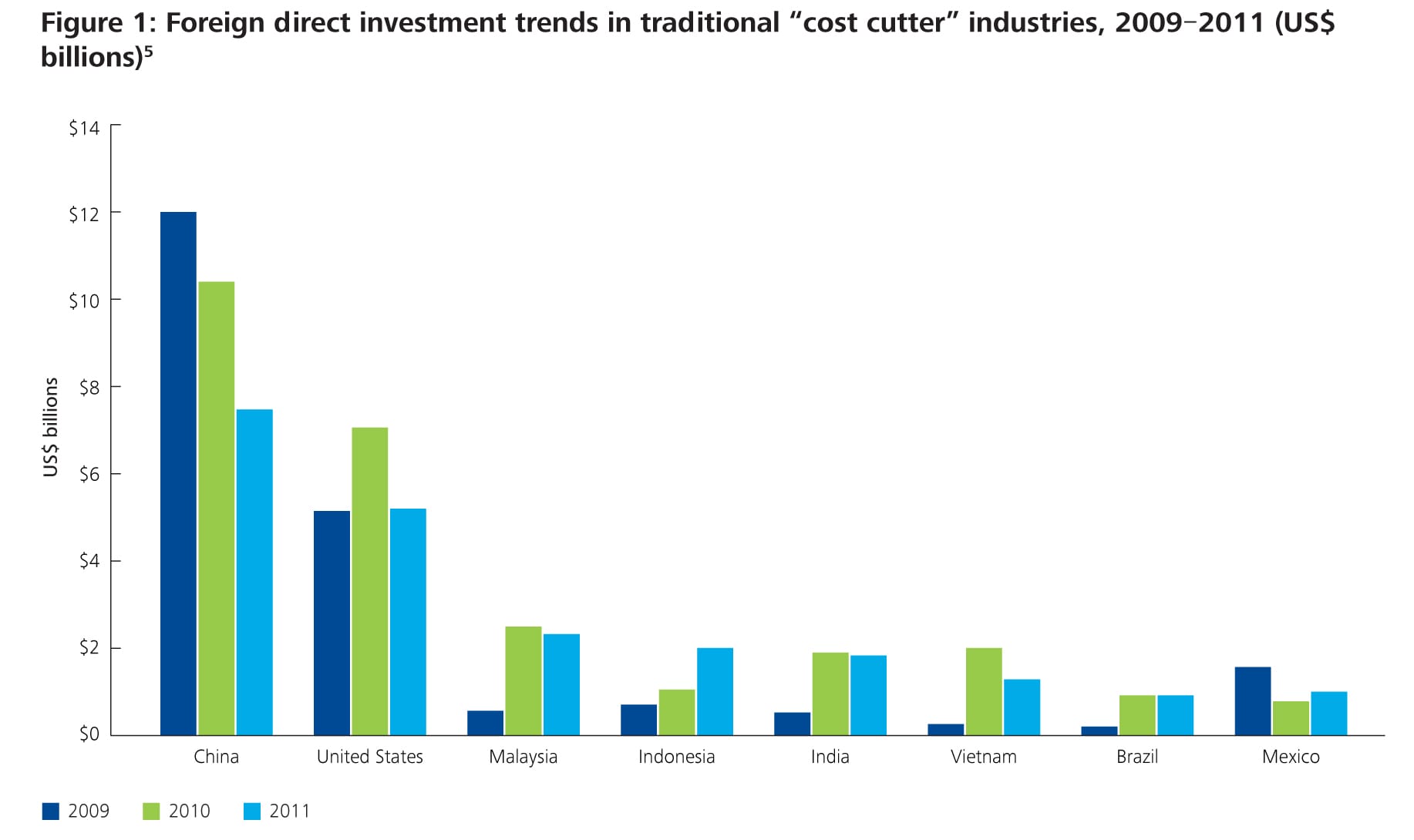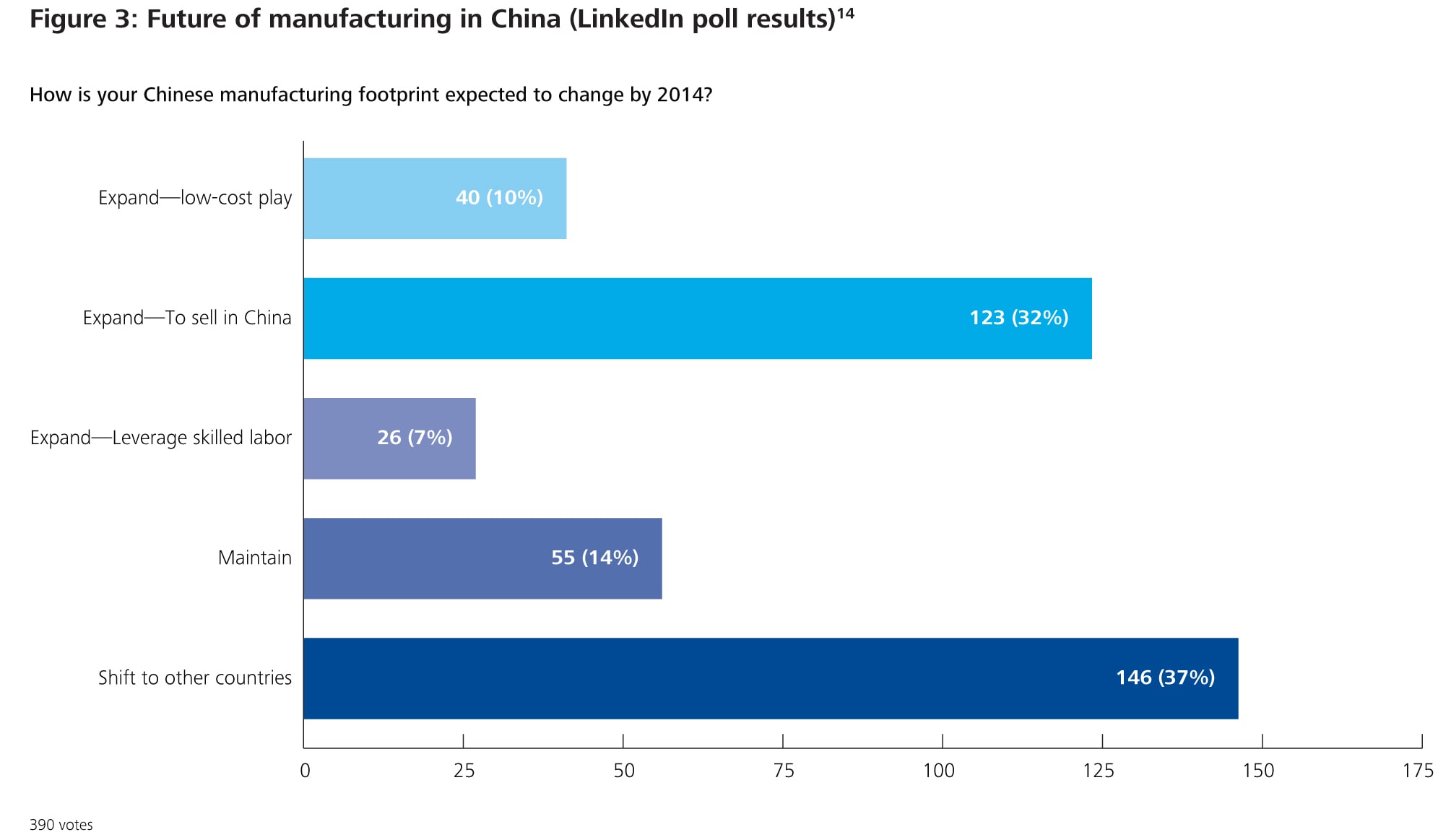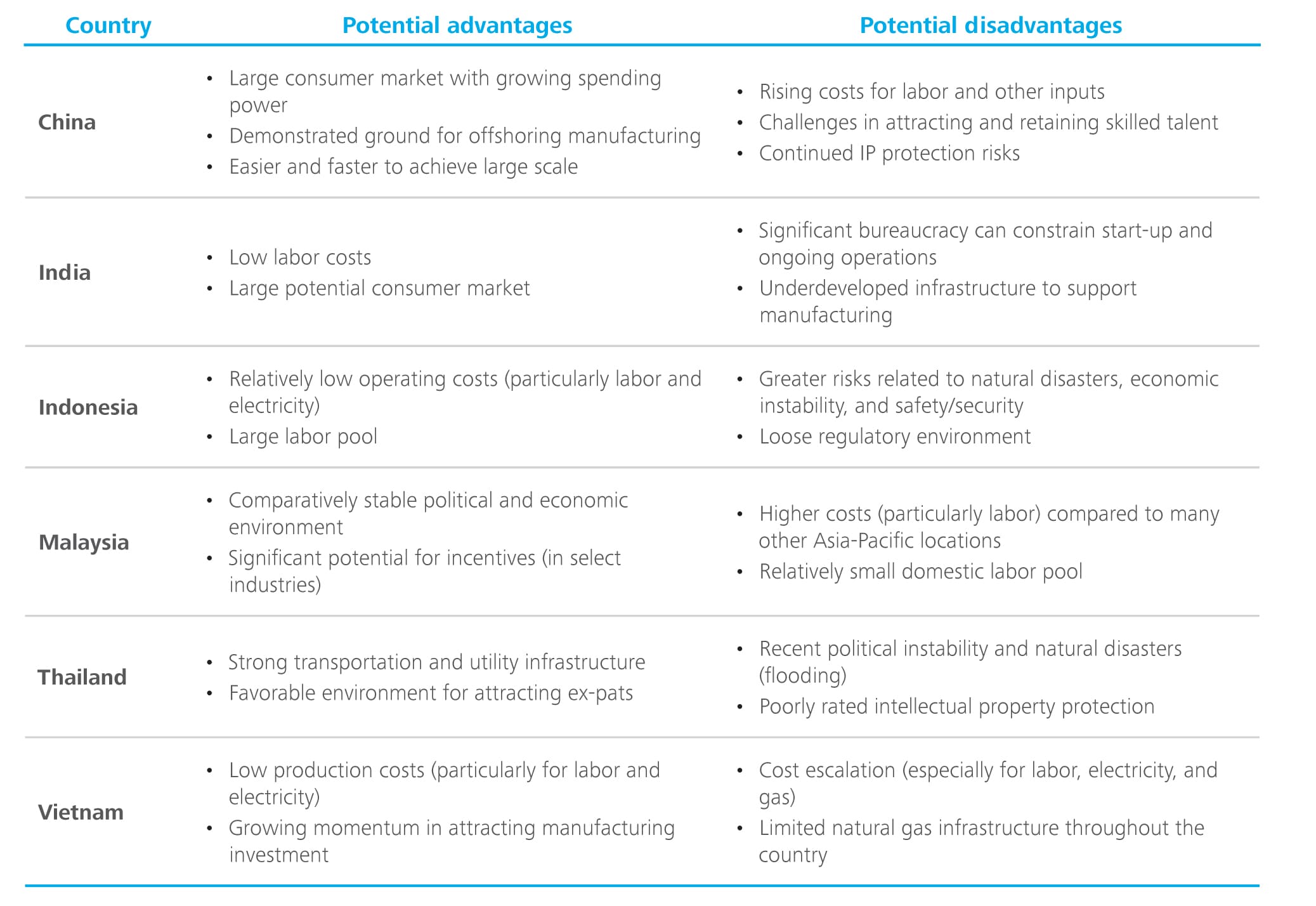Manufacturing beyond China has been saved

Manufacturing beyond China New options. New opportunities. New risks.
20 March 2013
- Darin Buelow, Doug Gish, Josh Timberlake
While China’s role in manufacturing will likely remain significant, its future course may veer away from “factory to the world” toward “factory to China.”
China has long been the default choice for offshore manufacturing. For the past two decades, many businesses have made the move without even seriously considering other countries. But that’s starting to change. Rising production costs and increasing competition for talent along with other factors such as intellectual property risk and dwindling government incentives are reducing China’s appeal for export-oriented manufacturers and prompting many companies to explore other production locations within Asia and beyond.
Overview
EXPLORE
Create and download a custom PDF of the Business Trends 2013 report.
Though China’s manufacturing base continues to grow, the rate has tapered in recent years. Perhaps equally important, the country’s vast production base is changing. Increasingly, new manufacturing capacity is being deployed to satisfy demand from Chinese consumers,1 rather than to serve the export market.
 Although China remains the dominant player in offshore manufacturing, several trends are causing companies that are highly cost-sensitive to consider alternative locations (figure 1). For example, China used to be the obvious choice—or even the only choice—for offshore production. However, businesses looking for low-cost export platforms in Asia are increasingly considering countries such as Indonesia, Vietnam, and Thailand. Others that are focused on reducing transportation costs and supply chain risk are shifting to nearshore locations closer to their customers, or even repatriating production to low-cost regions back home. A growing number of US companies are reconsidering—and in many cases moving production to—Mexico,2 which was once a favored spot for many US-based manufacturers. Many are also migrating to the southeastern United States.3 In fact, a recent Deloitte poll of more than 900 predominantly US-based executives and managers found that 39 percent believe their company is likely to deploy its next manufacturing operation in the United States, compared with only 16 percent who cited China as the likely destination.4
Although China remains the dominant player in offshore manufacturing, several trends are causing companies that are highly cost-sensitive to consider alternative locations (figure 1). For example, China used to be the obvious choice—or even the only choice—for offshore production. However, businesses looking for low-cost export platforms in Asia are increasingly considering countries such as Indonesia, Vietnam, and Thailand. Others that are focused on reducing transportation costs and supply chain risk are shifting to nearshore locations closer to their customers, or even repatriating production to low-cost regions back home. A growing number of US companies are reconsidering—and in many cases moving production to—Mexico,2 which was once a favored spot for many US-based manufacturers. Many are also migrating to the southeastern United States.3 In fact, a recent Deloitte poll of more than 900 predominantly US-based executives and managers found that 39 percent believe their company is likely to deploy its next manufacturing operation in the United States, compared with only 16 percent who cited China as the likely destination.4
See endnote 5
What’s driving this trend?
Several specific drivers, both internal and external to China, are causing manufacturers to increasingly seek alternative production locations:
- Labor costs and competition for talent are rising. Cheap, plentiful labor used to be China’s biggest advantage—but that benefit is shrinking. Deloitte’s recent poll found that rising labor costs and increased competition for labor are two of the biggest challenges for companies operating in China (figure 2). Foreign companies and fast-growing local businesses are all vying for qualified employees—especially workers with skills such as fluency in English—making it harder for businesses to attract and retain top talent. Wage inflation in Shanghai and other prime business locations, particularly along the eastern seaboard, has remained in the double digits for roughly a decade, with no apparent relief in sight.6
- Other costs are rising too. Depending on the industry, China may no longer be the cheapest place for foreign companies to do business. Real estate costs have risen at near-manic rates following the institution of government-mandated minimum land prices.7 Electricity rates are also rising,8 although the same is true in many other countries. And corporate income tax rates for most foreign companies have increased from 15 percent to 25 percent, while tax-related incentives are disappearing or becoming increasingly difficult to obtain.9
See endnote 12
- Intellectual property protection remains a risk. Foreign companies operating in China have long been worried about protecting their intellectual property; yet, despite the considerable attention this issue receives, it seems little progress has been made. Deloitte’s recent poll found that protection of intellectual property lingers as the top challenge for companies operating in China (figure 2).
- China’s competitors are steadily improving. Other countries in Asia have long offered appealing labor rates, and have also attracted inbound manufacturing investment (though to a much lesser degree than China). However, they often lacked the skilled workers and business infrastructure to support complex or large-scale manufacturing investment. That’s also changing. Nations such as India, Indonesia, Vietnam, Thailand, and others are becoming increasingly competitive. China still has an edge in advanced manufacturing with its ability to scale up massive production operations. For example, Foxconn grew its Chengdu manufacturing campus from scratch in 2010 to a reported 164,000 employees by December 2012,10 a growth rate that most likely could be achieved only in China. Yet many of China’s competitors have reached the point of viability, and will only get more competitive as they build critical mass and begin to attract more business. In addition, less developed regions, perhaps even Africa, may emerge in the not-too-distant future.
- Many companies are shortening their supply lines. Manufacturing products in China and then shipping them halfway around the world can be expensive, time-consuming, and risky. With a jittery economy causing demand fluctuations, being able to shorten supply chains and quicken response times while reducing exposure to volatile fuel prices is vital. That is why a growing number of companies are shifting production to nearshore or domestic locations, reducing supply chain costs and risk and making the business easier to manage.11 Leaders no longer have to subject themselves to all-day flights and midnight conference calls or settle for running their far-flung operations by remote control.
- China’s domestic consumption continues to rise. Despite the current and pending future challenges as a low-cost export platform, China will likely continue to attract manufacturing investment in droves to serve domestic consumers. Separately, manufacturers revealed that while 37 percent expect to shift production from China to other countries by 2014, nearly as many (32 percent) expect to expand in China to sell products locally (figure 3). Meanwhile, only 10 percent cited plans to grow their use of China as a low-cost platform. These findings suggest that while China’s role in manufacturing will likely remain significant, its future course may veer away from “factory to the world” toward “factory to China.”
See endnote 14
Lessons learned: What works and what doesn’t
When it comes to choosing a location for offshore production, there are a number of practical and demonstrated practices that can help you make an informed decision.
- Evaluate your game plan. Start by getting clarity about your organization’s strategic goals and objectives. Do you intend to reduce costs? Serve a new market? Expedite response times? Diversify risk? Because costs likely rise more quickly in less established countries, some organizations find themselves consistently playing catch-up as they seek to move from low- to lower-cost locations. Bringing broader organizational goals into the decision may support the long-term sustainability of your manufacturing investment.
- Assemble a cross-functional team. An effective assessment of potential manufacturing locations requires the involvement of a broad range of functions such as HR, supply chain, legal, and tax. Getting those functions engaged before choosing a location can help avoid unpleasant surprises down the road.
- Look beyond labor costs. The location with the lowest labor costs may not actually be the preferred one—or even the most cost-effective place to do business. To make the right choice, consider a wide range of factors, including everything from the cost of transportation and electricity to supply chain risk, workforce skills, and tax incentives. Identify and prioritize all the needs of your business, and then see how each location stacks up against your specific requirements. As companies apply more “total cost” decision models, past and future decisions to source in China will likely be called into question.
- Consider the entire supply chain. Many modern factories are really just assembly operations, with much of the actual manufacturing done by upstream suppliers. When deciding where to locate, proximity to suppliers should be an important factor. Proximity to customers (and to corporate headquarters) should also be taken into account. All else being equal, closer is usually preferred.
- Assess the current footprint. Manufacturers seeking a beachhead in Asia may steer toward China, especially if domestic market potential is an important consideration. Meanwhile, those that already have a deep China presence may see risk diversification as a driver, and be more apt to move existing production from China—or divert the next manufacturing investment—to another country.
- Understand the alternatives. For companies deploying cost-sensitive, export-oriented manufacturing in the Asia-Pacific region, a handful of countries most commonly emerge as alternatives to China. Each has its own set of advantages and disadvantages.13
Looking ahead
Two years from now, fewer businesses may automatically assume China is their leading option for low-cost, export-focused manufacturing. As production costs rise and other challenges intensify, many companies will likely feel increasingly fatigued by and overinvested in China as a low-cost export platform. If the emerging countries in the region continue along their current growth trajectory in the required labor, infrastructure, and supply base capabilities to support more complex foreign manufacturers, they may catapult themselves into consideration for all types of production expansion or relocation decisions involving the Asia-Pacific region.
China will also likely face growing competition from other parts of the world. A movement toward supply chain regionalization is already causing manufacturers based in North America and Europe to reevaluate far-flung supply lines, and in some cases, shift production closer to home. At the other end of the spectrum—for operations where cost trumps all factors—Africa lurks as the potential next frontier for low-cost manufacturing, assuming it can address the political, social, and infrastructure barriers that currently deter many foreign investors. Even China was once untested territory. Organizations that took the first step into China were well positioned to take full advantage of what has turned out to be an unprecedented growth wave. Many companies are now looking beyond China for the next wave.
Where it’s happening
The recent case of a US-based heavy equipment manufacturer embodies the dilemma faced by many Western manufacturers regarding China. This company continues to experience growing global demand for its product, driven by urbanization and infrastructure needs in emerging markets, particularly China. This increasing demand is particularly strong throughout the commodity-rich Asia-Pacific region, currently supplied by manufacturing plants in China and several North American facilities. However, the company faces many of the challenges typical with operating in China, including increasing pressures on cost, talent attraction and retention, and IP protection. These concerns, along with an overall desire to diversify production, led the company to investigate alternatives to China for its third production facility in the region.
While familiar with China from its two current operations, the company had limited knowledge or experience in other Asia-Pacific countries. After defining and prioritizing the specific decision drivers for the new plant location (for example, electric power reliability, quality, and costs were particularly important), the company filtered the region down to the short list of countries that could realistically deliver on their objectives—and then went into the field to investigate the top candidate industrial zones.
In-depth analysis of the cost and non-cost considerations in each location led to many interesting insights:
Several countries demonstrated the capability to support an operation of the proposed scale ($60 million in capital investment and 250–300 employees).
Viable candidate countries offered savings ranging from 7 to 22 percent in “geographically variable” costs, such as labor, utilities, real estate, and freight, compared to China.
Aside from potential cost savings, some countries also appeared to offer more favorable operating conditions, including talent, infrastructure, and risk environment, based on the company’s particular preferences and requirements for the new operation.
Despite the opportunities, there are risks associated with expanding elsewhere in Asia. China’s challenges, while significant, are well known and understood by the company. There is also concern that expansion outside of China will stretch the company’s Asia-Pacific management team too thin. The company is currently evaluating these dynamics and also examining the potential to serve Asia by increasing production capacity in North America as it narrows in on a final deployment decision for the new factory.
China will likely remain a dominant player in global manufacturing for the foreseeable future, and will likely continue to be the leading production option for many companies, especially those serving markets in China and other parts of Asia. However, it is no longer the only option. Manufacturers are already starting to look further afield, and may increasingly consider alternative locations both within and outside the Asia-Pacific region. When choosing a location, more companies may take a holistic, long-term view that examines operating costs, business conditions, and risks, and then make decisions based on their own specific business requirements.
My take
Deborah L. Wince-Smith, President and CEO, Council on Competitiveness
China will likely remain a manufacturing powerhouse. Supply networks, talent pool, infrastructure, and other factors, including government policies and investments, are too entrenched in the fabric of global manufacturing for China to be displaced in the near future. China’s position atop our 2013 Global Manufacturing Competitiveness Index rankings15 indicates that CEOs around the world believe China’s manufacturing strength seems secure for the next five years.
The changing global manufacturing dynamic also favors expanding manufacturing in the United States, as we point out in our Council on Competitiveness’ national manufacturing strategy publication Make: An American Manufacturing Movement. US-based production addresses many of the challenges in China, ranging from shorter cycle times and supply chain challenges to energy and transportation costs, IP protection, and market access.
The United States is expected to remain a leading manufacturing competitor—poised to lead the technological transformation in manufacturing. Today, US manufacturing remains at the technological forefront—and companies are investing here to seek access to cutting-edge US automation and robotic technology.
Several forces are shaping China’s manufacturing outlook. Internal factors such as rising production costs and competition for skilled labor continue to pose challenges for many manufacturers. Externally, several emerging countries in Asia, including Vietnam, Indonesia, and Malaysia, already rank among the 20 most competitive manufacturing countries, and their competitive positions are only slated to improve. Likely improvements in manufacturing competitiveness drivers—such as talent-driven innovation, physical infrastructure, and supplier network—will make Southeast Asia the strongest ascending region over the next five years. Individually, these countries pose a small threat to China. Collectively, however, they are positioned to erode China’s role as the default choice for cost-driven, export-oriented production.
Global manufacturers are taking notice—and are increasingly thinking about alternatives for manufacturing beyond China, including the United States.




